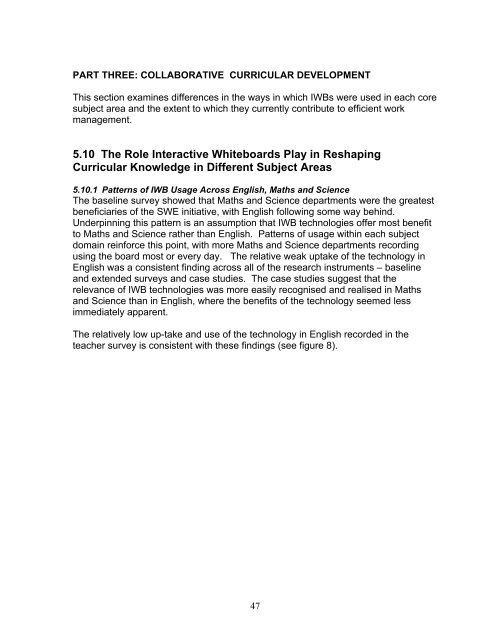The Interactive Whiteboards, Pedagogy and Pupil Performance ...
The Interactive Whiteboards, Pedagogy and Pupil Performance ...
The Interactive Whiteboards, Pedagogy and Pupil Performance ...
You also want an ePaper? Increase the reach of your titles
YUMPU automatically turns print PDFs into web optimized ePapers that Google loves.
PART THREE: COLLABORATIVE CURRICULAR DEVELOPMENT<br />
This section examines differences in the ways in which IWBs were used in each core<br />
subject area <strong>and</strong> the extent to which they currently contribute to efficient work<br />
management.<br />
5.10 <strong>The</strong> Role <strong>Interactive</strong> <strong>Whiteboards</strong> Play in Reshaping<br />
Curricular Knowledge in Different Subject Areas<br />
5.10.1 Patterns of IWB Usage Across English, Maths <strong>and</strong> Science<br />
<strong>The</strong> baseline survey showed that Maths <strong>and</strong> Science departments were the greatest<br />
beneficiaries of the SWE initiative, with English following some way behind.<br />
Underpinning this pattern is an assumption that IWB technologies offer most benefit<br />
to Maths <strong>and</strong> Science rather than English. Patterns of usage within each subject<br />
domain reinforce this point, with more Maths <strong>and</strong> Science departments recording<br />
using the board most or every day. <strong>The</strong> relative weak uptake of the technology in<br />
English was a consistent finding across all of the research instruments – baseline<br />
<strong>and</strong> extended surveys <strong>and</strong> case studies. <strong>The</strong> case studies suggest that the<br />
relevance of IWB technologies was more easily recognised <strong>and</strong> realised in Maths<br />
<strong>and</strong> Science than in English, where the benefits of the technology seemed less<br />
immediately apparent.<br />
<strong>The</strong> relatively low up-take <strong>and</strong> use of the technology in English recorded in the<br />
teacher survey is consistent with these findings (see figure 8).<br />
47

















